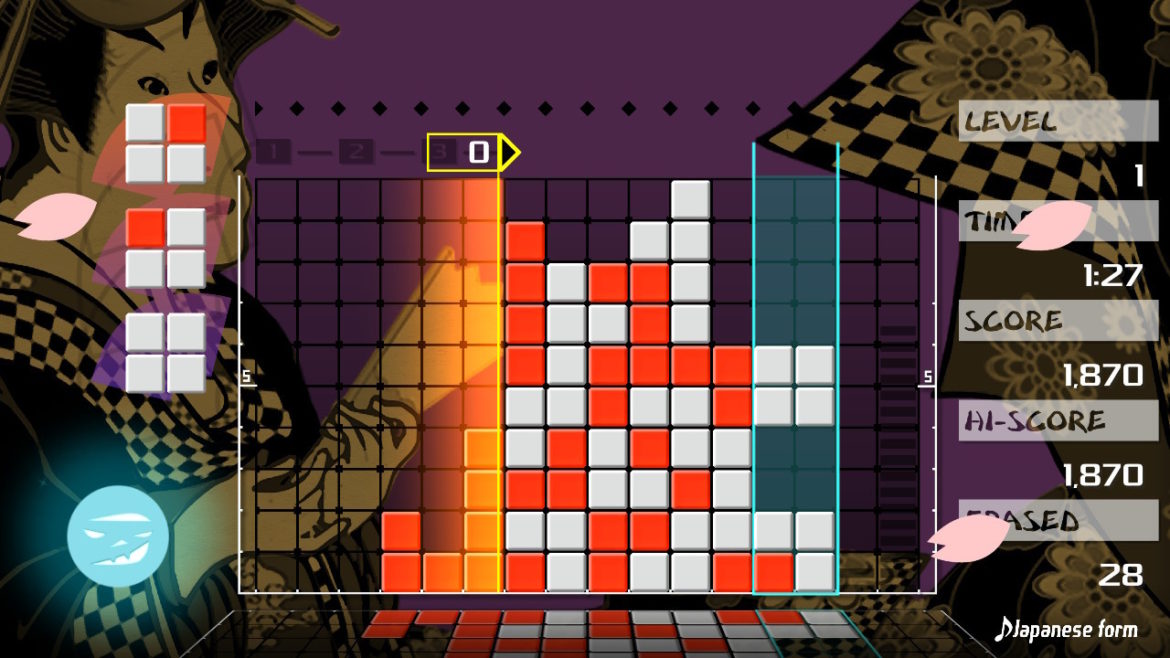
Seconds after I started up Challenge Mode in Lumines Remastered, Mondo Grosso’s “Shinin’” perked up and the energetic sounds of an acoustic guitar began to weave around a trance beat. I dropped my first block, and quickly cleared the first sparkling squares of the stage, triggering that familiar twinkle sound effect. Suddenly, it was like 2004 was yesterday, 10 stages were unlocked before I even knew 45 minutes had passed, and I realized just how much I missed Lumines.
It shouldn’t have been a surprise. Many of Tetsuya Mizuguchi’s music-based games dabble in synesthesia, the concept of associating one kind of sensory memory with another. In Mizuguchi’s games, it’s the persistent marriage of sound, sight, and even touch. Lumines isn’t as all-encompassing an experience as Rez or Child of Eden–though, in a nice touch, if you have the extra controllers, Lumines Remastered does include Rez’s Trance Vibration options–but the way that it plays havoc with your senses is very much in line with Mizuguchi’s other work.
At its most basic, Lumines is a color-matching game where 2×2 blocks of two colors in various configurations drop from the top of the screen, and your challenge is to create solid squares of the same color at the bottom. At minimum, you can create a 2×2 brick, but even bigger configurations can be made if you’re quick and strategic enough to line them up. Every stage is, essentially, a self-contained EDM-centric environment, with its own visual scheme, song, and rhythm, which dictates how fast completed blocks can be cleared by the line that travels across the screen. As the line moves it highlights and removes any squares you’ve made, potentially resulting in huge, gratifying bursts of light and sound.
Lumines starts simple but steadily escalates into frantic, eye-popping chaos by the end of each track. Because the rhythm of a particular song dictates the flow of a level and the pace of your block-clearing opportunities, failure in Lumines feels like dancing awkwardly and gradually losing the ability to catch the beat. On the other hand, successfully creating blocks and forming large combos measure after measure is like falling into a trance on the dance floor and losing yourself to the music.
Lumines Remastered isn’t a vast visual jump over the hitherto best-looking version of the game, the Xbox 360/PS3 edition. It is, however, noticeably cleaner, without the slowdown that sometimes afflicted other versions when the game is at its busiest. The visual enhancements are more appreciable when comparing the mobile and Vita versions against the Switch version in handheld mode. While most previous Lumines modes are present in Remastered, you won’t find Single Skin mode (where you could stick with one particular stage/song for an entire playthrough), the Sequencer from Lumines II (where you could create your own soundtracks), and–quite disappointingly–any sort of online multiplayer.
The lack of online features hurts the most, but it’s not like Lumines is short on replay value. Beyond the regular Challenge modes, you still get a Time Attack, Puzzle Mode, Mission Mode, and a VS mode against either the CPU or a second player. Between Puzzle and Mission Mode, there are hundreds of bonus tasks to tackle, and many will make you scratch your head for hours on end while never feeling impossible.

Puzzle Mode will challenge you to clear squares in such a way that the leftover blocks create a specific, assigned shape, like a blocky horse or a screen-wide X. It’s more about creative placement and a sense of foresight than anything–similar to building something out of Lego, except the bricks have a nasty habit of disappearing. Mission Mode’s tasks can vary between strict single-solution challenges, especially early on, to simple races against the clock. It’s easier, but no less entertaining. VS mode is pretty much exactly what it says it is: Lumines, but where two players play using half of the playing area each, and every cleared square pushes the boundary of the playing area towards your opponent, enpanding the amount of space you have to play with and shrinking it for your enemy.
Lumines is the kind of game that temporarily rewires your brain, splicing together its ability to recognize visual patterns and audible rhythms simultaneously and forcing you to do the hard but delightful work of putting that ability to use. Having that experience so lovingly presented–and on the Switch, having Lumines handheld again for the first time in six years–is an occasion worth celebrating.


